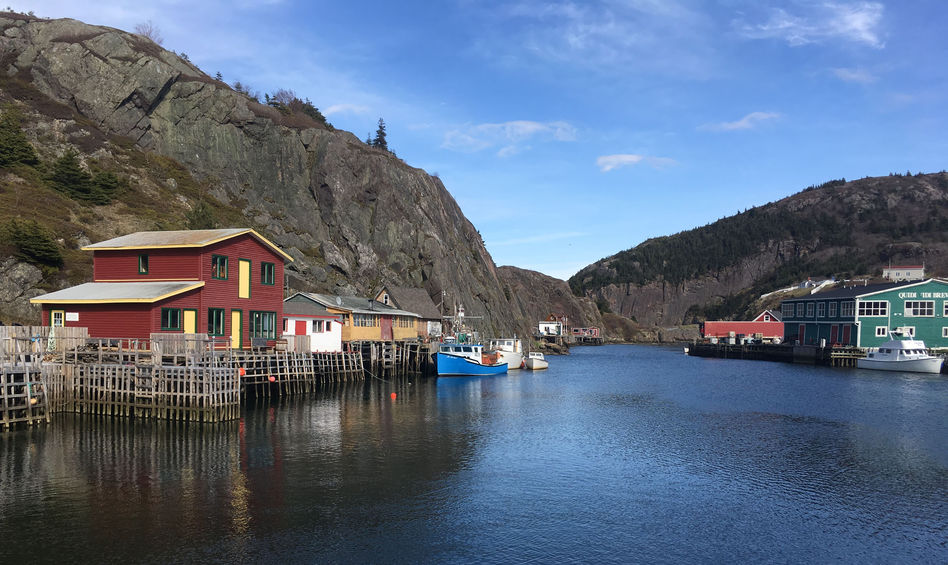Article content
19 February 2019 by Andy Austen
Having just returned from Newfoundland and Labrador, Wexas specialist Andy Austen gives the lowdown on the unique heritage and stunning natural beauty of Canada’s easternmost region. After explaining why it’s all a lot closer than you think, he picks out the two best driving routes before finishing with the island’s national-park wonder and one of the world’s most impressive luxury lodges. Here's the contents:
St. John’s
With a flight time of just over five-and-a-half hours from the UK, it almost feels wrong to classify St. John’s as a long-haul destination, especially when you consider the colonial charm of this colourful port city. However, as the oldest city in North America, it’s very much its own place – something I witnessed first-hand on Signal Hill National Historic Site. From here, I watched as both whales and great hunks of ice drifted along “Iceberg Alley” – a world away from the views of Faversham Creek back at home. Appropriately, this is also where the very first transatlantic wireless signal was received, in 1901.
And, much of the town seems to owe something to its privileged setting. I spent a very happy afternoon tasting my way through beers brewed from iceberg meltwater at Quidi Vidi Brewery, while the bustling crab and cod fishing fleets keeps the restaurants in just-caught delicacies. The cod cheeks at Merchant Tavern were a personal favourite. Indeed, there’s an excellent dining scene here, complemented by plenty of live music, with the city’s Irish roots sung out in the bars of George Street.
St. John’s never seems to get ahead of itself, with a strict city ordnance forbidding high-rise development. It’s an absolute pleasure to admire the fishermen’s sheds stilted out over the water or the diminutive “jellybean” houses, so called for their brightly painted colours. Even the accommodation falls into line, with St. John’s offering a number of excellent boutique inns. My pick is the Leaside Manor for its Jacuzzi tubs and hearty hot breakfasts, served in the room.

Quidi Vidi Brewery. Credit: Andy Austen
The Irish Loop
Looping around the Avalon Peninsula’s south-eastern extreme, this is the region’s quintessential driving route, skirting wild coastline and plunging through old-growth forests to showcase Newfoundland’s unique history. Its 185 miles take in plenty of charming settlements along the way, ideal for a long day-trip out of St. John’s or a more relaxing multi-day journey. And, on picking up my hire car, my first stop was the historic Cape Spear Lighthouse National Historic Site. Fittingly for a route named for the region’s Irish-immigrant heritage, it marks the most easterly point in North America – next stop County Clare, Ireland.
It was then on to Bay Bulls, where I joined a coastal cruise with the Gatherall family. They’ve been operating whale-watching boats since the region’s fishing-industry decline, and were able to point me towards minke whales, puffins and bald eagles, sitting proudly in the treetops on the adjacent cliffs. I washed it all down with a lunch of local fish and chips at the superb Bernard Kavanagh’s Restaurant.

Wexas specialist Andy Austen with a local Newfoundland
The coast then brought me on to Ferryland – the site of the first permanent European settlement in north America. Although dating to 1621, it was only recently rediscovered and is still being excavated today. You’ll be able to peer over the shoulders of archaeologists as they unearth cobbled streets, bakeries and even whole houses. The accompanying Ferryland Lighthouse is also the perfect spot for a picnic, pairing molasses oatmeal sandwiches with gorgeous coastal scenery. Then, looping back towards St. John’s, there’s everything from the fossils of the Edge of Avalon's UNESCO-listed Mistaken Point to the quaint seaside town of St. Mary’s. It’s all linked by yet more stunning coastal scenery.
Find out more about our St. John's and the Irish Loop itinerary
The Baccalieu Trail
With the Irish Loop best for taking in the local history, this route is all about the scenery, offering plenty of chances for hiking and wildlife watching. Instead of turning south out of St. John’s, I headed west towards the peninsular Baccalieu Trail, forming Newfoundland’s northwestern reach.
The route brings you along a spectacularly fissured coast, weaving between cragged coves and pretty bays, home to idyllic fishing villages. It’s all knitted together by quiet country roads and a series of intriguing stops. Highlights include the archaeological dig of Canada’s first English settlement, the site where Brunel’s Great Eastern steamship hauled ashore the first permanent transatlantic cable, and the aptly named Wooden Boat Museum. It showcases a wealth of personal experience alongside the broader story of the province’s fishing communities.
Of course, it would be remiss of me not to point out a place or to eat, drink and stay. Rose Manor Inn remains a Wexas favourite for its Victorian teas and oceanfront setting in the small village of Harbour Grace. Otherwise, for something a bit different, head to Dildo for an excellent craft brewery before perhaps spending the night in Brigus. With its weatherboard houses and picturesque harbour, it’s got a palpable “New England” feel.

Newfoundland scallops. Credit: Andy Austen
Fogo Island
A ferry trip from the mainland, Fogo is a getaway from a getaway. It’s a wild island of jagged coasts and a forested interior, where things tend to follow the seasons, from winter’s pack ice to autumns spent foraging for berries. It’s all explored on gorgeous walks and boat rides, each offering the chance to spot (or fish for) the resident wildlife. Expect everything from caribou and nesting puffins to Newfoundland ponies and great pods of whales.

Fogo Island Inn
However, what really put Fogo Island on the map was the construction of one of the world’s finest luxury lodges – Fogo Island Inn. It’s an icon of stilted Scandinavian design, where views across the island and ocean are invited in by giant floor-to-ceiling views. It’s scenery that inspires a full-board gourmet menu of just-caught seafood and freshly foraged ingredients. And, when you return from the included activities, you’ll be able to relax in the sauna and hot tubs safe in the knowledge that the profits go right back into the local community.
Find out more about our Fogo Island Inn itinerary
Gros Morne National Park
The Norwegian fjords seem to get a lot of attention these days, but, for my money, UNESCO-listed Gros Morne is equal to any of its Scandinavian rivals. Its 1,850 square kilometres are a slice of untouched wilderness, where mountain peaks roll down into river canyons, themselves tumbling towards the shore in a series of green-dappled contours.

Boat tour on Western Brook Pond, Gros Morne
In short, it’s an outdoorsman’s paradise, best explored on one of the many excellent hiking trails, discovering hidden waterfalls and taking in a landscape carved by glaciers millennia ago. Otherwise, let the boat take the strain with a cruise along its mighty waterways before ending the day in one of the humble towns that dot its coast. Expect yet more delectable seafood and some fine, welcoming lodgings.
Find out more about our Gros Morne and Newfoundland itinerary
Lastly, although I’ve picked out a few of my favourite itineraries below, please also don’t hesitate to get in contact with one of our Canada specialists today. For more information, fill out an enquiry form or call us on 020 7590 0610.



